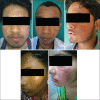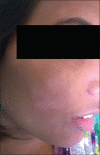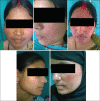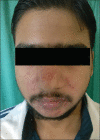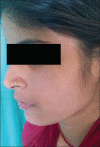Misuse of topical corticosteroids on the face: A cross-sectional study among dermatology outpatients
- PMID: 27559498
- PMCID: PMC4976402
- DOI: 10.4103/2229-5178.185492
Misuse of topical corticosteroids on the face: A cross-sectional study among dermatology outpatients
Abstract
Background: Topical corticosteroids (TC) are being misused widely on the face without a prescription from the dermatologist.
Aim: To evaluate the misuse of TC-containing preparations on the face and the adverse effects due to its application.
Materials and methods: A questionnaire-based analysis was done among patients attending the dermatology outpatient department of a tertiary care hospital between March 2014 and March 2015. Patients with various facial dermatoses were asked about their current use of topical preparations and on further followup questioning, those who revealed the use of TCs (25g or more) continuously or intermittently for a minimum duration of four weeks were included in the study and observed for local adverse effects.
Results: A total of 410 patients were observed, 306 were females (74.6%) and 104 were males (25.3%). One hundred and seventy-eight patients (43.4%) used topical steroids alone, 124 (30.2%) used creams containing TC, hydroquinone, and tretinoin, 108 (26.3%) used creams containing a combination of TC, antibiotic, and/or antifungal. One hundred and seventy-six patients (42.9%) bought TC or TC containing creams over the counter on their own, without the prescription of a dermatologist, 35 (8.5%) were recommended TC by a beautician (beauty parlors), 82 (20%) by their friends, family members, or neighbors, 75 (18.2%) by a non-dermatologist practitioner, and 42 (10.2%) by a dermatologist.
Limitations: The sample size was small.
Conclusion: Dispensing of TCs must be regulated in India; they should only be issued against a doctor's prescription.
Keywords: Misuse; combination cream; topical steroids.
Figures
Similar articles
-
Topical Steroid Damaged/Dependent Face (TSDF): A Study from a Tertiary Care Hospital in Eastern India.Indian J Dermatol. 2018 Sep-Oct;63(5):375-379. doi: 10.4103/ijd.IJD_218_17. Indian J Dermatol. 2018. PMID: 30210157 Free PMC article.
-
Topical corticosteroid abuse on the face: a prospective, multicenter study of dermatology outpatients.Indian J Dermatol Venereol Leprol. 2011 Mar-Apr;77(2):160-6. doi: 10.4103/0378-6323.77455. Indian J Dermatol Venereol Leprol. 2011. PMID: 21393945
-
Study of Clinical Profile of Patients Presenting with Topical Steroid-Induced Facial Dermatosis to a Tertiary Care Hospital.Indian Dermatol Online J. 2020 Mar 9;11(2):208-211. doi: 10.4103/idoj.IDOJ_259_19. eCollection 2020 Mar-Apr. Indian Dermatol Online J. 2020. PMID: 32477980 Free PMC article.
-
Cross-Sectional Review of Prescription Practices of Triple Action Creams Amongst Doctors in South-East.Niger Med J. 2022 Apr 26;62(3):96-103. eCollection 2021 May-Jun. Niger Med J. 2022. PMID: 38505193 Free PMC article. Review.
-
Ocular side-effects of topical corticosteroids: what a dermatologist needs to know.Australas J Dermatol. 2015 Aug;56(3):164-9. doi: 10.1111/ajd.12292. Epub 2015 Mar 5. Australas J Dermatol. 2015. PMID: 25754554 Review.
Cited by
-
Systemic glucocorticoid prescriptions pattern and factors of inappropriate use in primary care institutions of Southwest China.Front Public Health. 2022 Sep 12;10:952098. doi: 10.3389/fpubh.2022.952098. eCollection 2022. Front Public Health. 2022. PMID: 36172212 Free PMC article.
-
Misuse of Topical Corticosteroids for Cosmetic Purpose in Antananarivo, Madagascar.Biomed Res Int. 2017;2017:9637083. doi: 10.1155/2017/9637083. Epub 2017 Aug 21. Biomed Res Int. 2017. PMID: 28904977 Free PMC article.
-
Prevalence of Misuse of Topical Corticosteroid among Dermatology Outpatients.JNMA J Nepal Med Assoc. 2020 Nov 22;58(231):834-838. doi: 10.31729/jnma.5271. JNMA J Nepal Med Assoc. 2020. PMID: 34506417 Free PMC article.
-
Topical steroids: Awareness and misuse among patients, pharmacists and general medical practitioner.Indian J Dermatol Venereol Leprol. 2021 Jan-Feb;87(1):54-59. doi: 10.4103/ijdvl.IJDVL_84_18. Indian J Dermatol Venereol Leprol. 2021. PMID: 30971536
-
The Use of Over-the-Counter (OTC) Skin-Lightening Agents and Their Side Effects Among the Residents of Saudi Arabia: A Cross-Sectional Study.Cureus. 2024 Jun 21;16(6):e62832. doi: 10.7759/cureus.62832. eCollection 2024 Jun. Cureus. 2024. PMID: 39036177 Free PMC article.
References
-
- Smith EW. Do we need new and different glucocorticoids. A re-appraisal of the various congeners and potential alternatives? Curr Probl Dermatol. 1993;21:1–10. - PubMed
-
- Lu H, Xiao T, Lu B, Dong D, Yu D, Wei H, et al. Facial corticosteroid addictive dermatitis in Guiyang city, China. Clin Exp Dermatol. 2010;35:618–21. - PubMed
-
- Liu ZH, Du XH. Quality of life in patients with facial steroid dermatitis before and after treatment. J Eur Acad Dermatol Venereol. 2008;22:663–9. - PubMed
-
- Al-Dhalimi MA, Aljawahiry N. Misuse of topical corticosteroids: A clinical study in an Iraqi hospital. East Mediterr Health J. 2006;12:847–52. - PubMed
-
- Saraswat A, Lahiri K, Chatterjee M, Barua S, Coondoo A, Mittal A, et al. Topical corticosteroid abuse on the face: A prospective, multicenter study of dermatology outpatients. Indian J Dermatol Venereol Leprol. 2011;77:160–6. - PubMed
LinkOut - more resources
Full Text Sources
Other Literature Sources

